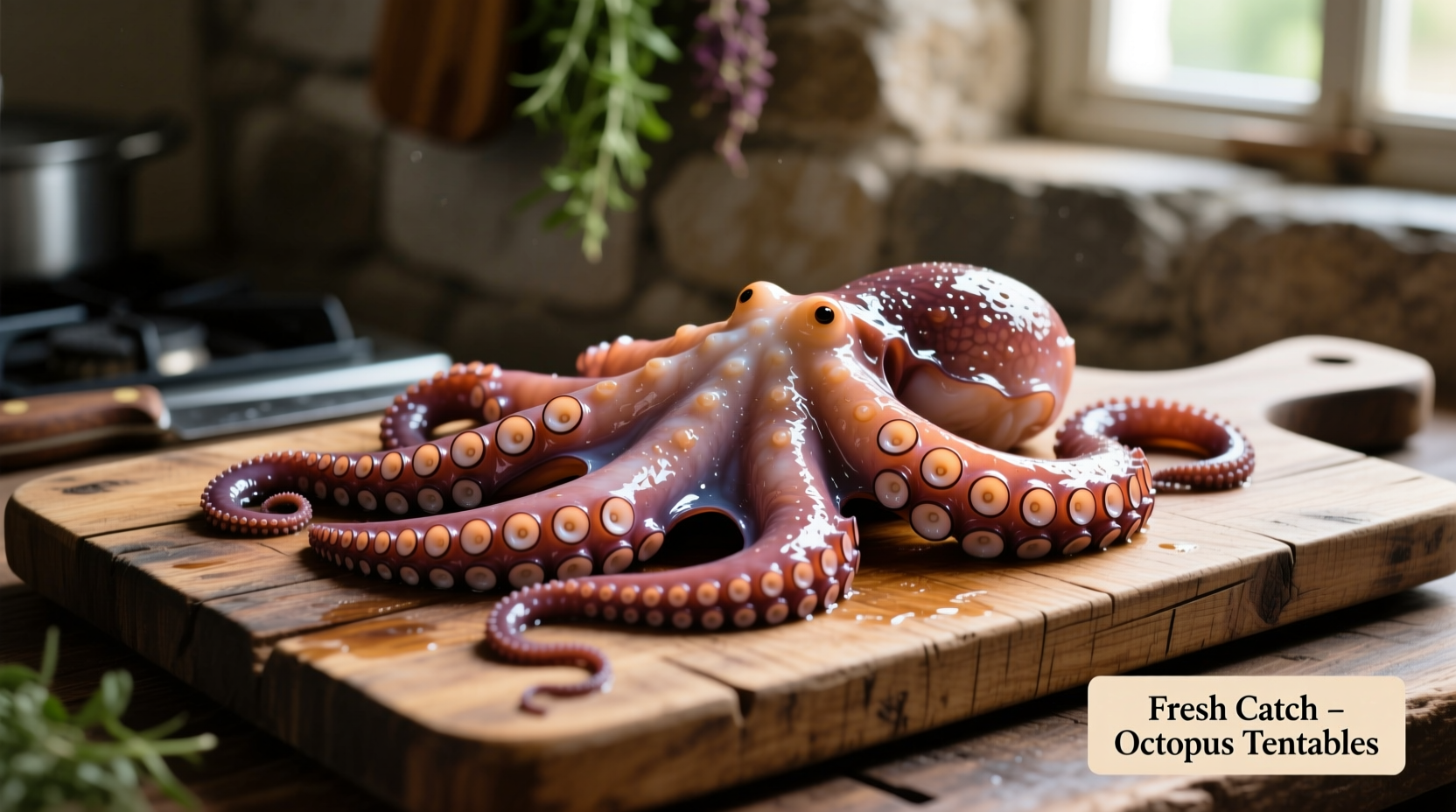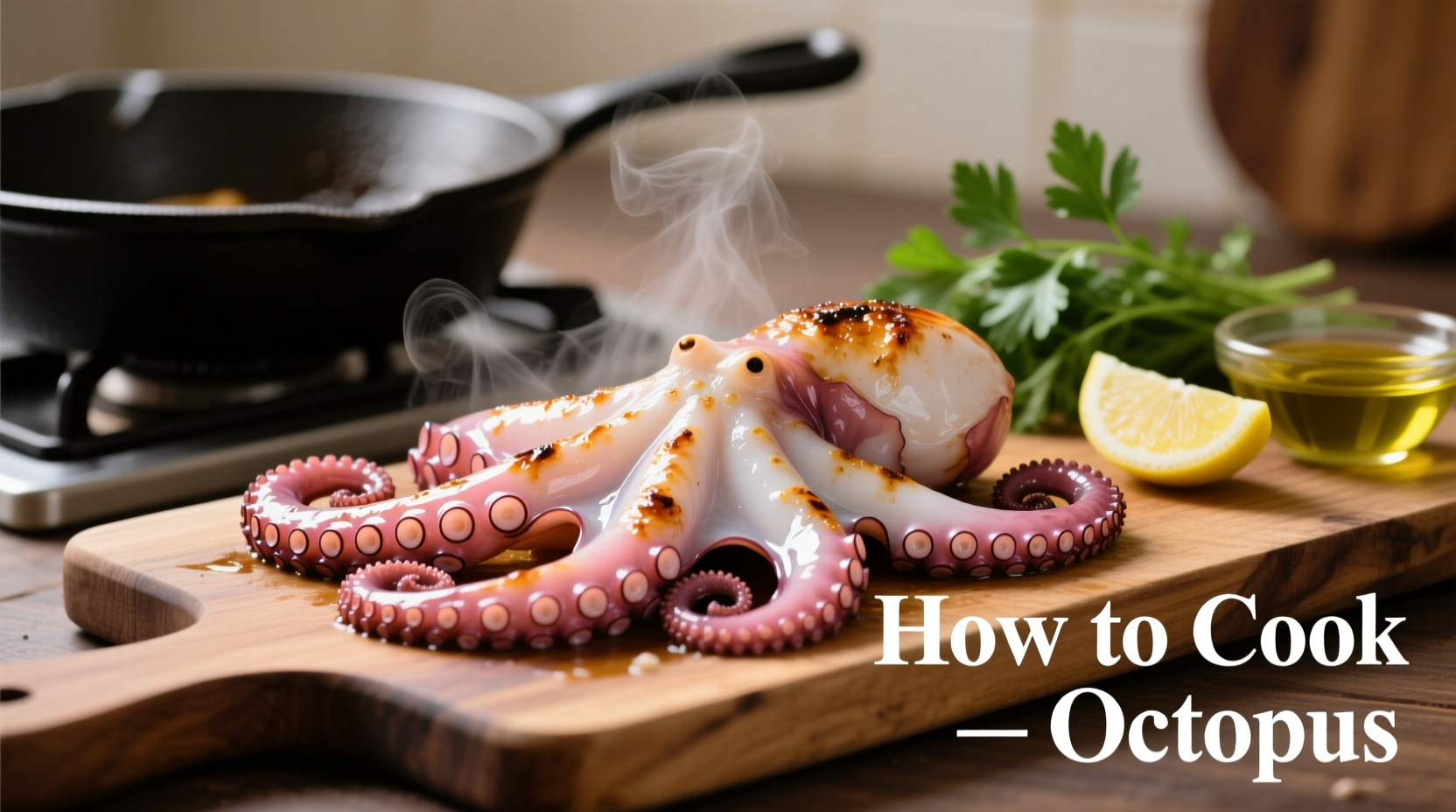The most reliable method to cook octopus involves simmering it gently in salted water for 45-60 minutes until tender, then finishing with high-heat techniques like grilling or pan-searing for optimal texture and flavor. Proper tenderizing before cooking is essential to avoid chewy results.
If you've ever wondered how do you cook octopus without ending up with rubbery, chewy results, you're not alone. Many home cooks struggle with this delicate seafood, but with the right techniques, you can achieve restaurant-quality octopus that's tender on the inside with a beautifully caramelized exterior. This comprehensive guide reveals professional methods backed by culinary science to transform octopus from intimidating to irresistible.
Selecting the Perfect Octopus
Choosing quality octopus is your first step toward success. Look for these key indicators at your fishmonger:
- Freshness signs: Clear, bright eyes and firm, springy flesh that bounces back when pressed
- Color: Vibrant reddish-brown hue (avoid grayish or dull specimens)
- Smell: Clean ocean scent without strong ammonia odors
- Size matters: Smaller octopuses (2-3 pounds) tend to be more tender than larger varieties
According to the U.S. Food and Drug Administration, proper seafood selection reduces food safety risks while maximizing flavor potential. Always purchase from reputable seafood suppliers who maintain proper cold chain storage.
Essential Preparation Techniques
Before you begin cooking octopus, proper preparation makes all the difference. Follow these professional steps:
- Clean thoroughly: Rinse under cold water, removing any sand or debris from the tentacles
- Remove beak: Locate the hard beak at the center of the tentacles and push it out through the top
- Tenderize: Either freeze the octopus overnight (natural tenderizing through ice crystal formation) or use a traditional Mediterranean method of "massaging" with coarse salt
Chef Antonio Rodriguez explains: "Freezing breaks down muscle fibers naturally, while the salt method works through osmosis. Both techniques help achieve that perfect tender texture without expensive equipment."

Step-by-Step Cooking Methods
Now for the crucial question: how do you cook octopus properly? These tested methods deliver consistent results.
| Cooking Method | Time Required | Best For | Pro Tips |
|---|---|---|---|
| Simmering | 45-60 minutes | All cooking applications | Add bay leaves and wine cork to water for enhanced tenderness |
| Pressure Cooking | 15-20 minutes | Weeknight meals | Use natural release only to prevent toughening |
| Grilling | 3-5 minutes per side | Summer entertaining | Brush with olive oil and lemon juice before high-heat searing |
| Pan-Searing | 2-3 minutes per side | Restaurant-quality presentation | Pat completely dry before cooking for perfect caramelization |
The Traditional Simmering Method
This classic approach remains the most reliable technique for home cooks asking how do you cook octopus:
- Place octopus in a large pot with enough cold water to cover
- Add 2 tablespoons coarse salt per gallon of water
- Include aromatics: 2 bay leaves, 1 chopped onion, 3 garlic cloves, and juice of 1 lemon
- Bring to a gentle simmer (not boiling) over medium heat
- Cook for 45-60 minutes until tender (test by inserting a knife)
- Remove from water and pat completely dry before finishing
Food science reveals why gentle simmering works best: boiling causes proteins to contract violently, while simmering allows gradual denaturation. As noted in USDA research on seafood preparation, maintaining water temperature below 180°F prevents toughening of delicate muscle fibers.
Finishing Techniques for Maximum Flavor
After simmering, these finishing methods transform tender octopus into spectacular dishes:
- Grilling: High heat creates beautiful char marks while concentrating flavors. Brush with olive oil and lemon before grilling.
- Pan-searing: Achieve crispy edges in a cast-iron skillet with minimal oil for restaurant-quality presentation.
- Broiling: Perfect for finishing when outdoor cooking isn't possible.
"The key to perfect grilled octopus," shares Chef Rodriguez, "is ensuring the surface is completely dry before it hits the heat. Any moisture creates steam instead of that beautiful caramelization we're after."
Avoiding Common Mistakes When Cooking Octopus
Even experienced cooks make these preventable errors:
- Skipping tenderizing: Raw octopus requires proper tenderizing to avoid chewy results
- Boiling instead of simmering: Vigorous boiling toughens the meat
- Overcooking: Once tender, additional cooking makes octopus rubbery
- Insufficient drying: Moisture prevents proper searing after simmering
According to culinary research from the Culinary Institute of America, proper octopus preparation follows a clear progression: tenderize → simmer gently → dry thoroughly → finish with high heat. Deviating from this sequence often leads to disappointing results.
Serving Suggestions and Flavor Pairings
Complete your octopus dish with these professional pairing recommendations:
- Mediterranean style: Toss with olive oil, lemon juice, fresh parsley, and Kalamata olives
- Asian fusion: Glaze with soy-ginger marinade and serve with pickled vegetables
- Spanish tapas: Drizzle with smoked paprika oil and serve with roasted potatoes
- Salad presentation: Slice tentacles and arrange over arugula with citrus vinaigrette
Remember that properly cooked octopus has a delicate, slightly sweet flavor that pairs beautifully with bright, acidic elements. Avoid overpowering it with heavy sauces that mask its natural taste.
Storage and Reheating Tips
If you're wondering how do you cook octopus for meal prep, proper storage maintains quality:
- Refrigerate cooked octopus in airtight container for up to 3 days
- Freeze for longer storage (up to 2 months) in vacuum-sealed bags
- Reheat gently in simmering water or broth to maintain tenderness
- Avoid microwaving, which can make octopus rubbery
Food safety experts at the USDA Food Safety and Inspection Service recommend cooking octopus to an internal temperature of 145°F (63°C) or until the flesh is opaque and flakes easily with a fork.











 浙公网安备
33010002000092号
浙公网安备
33010002000092号 浙B2-20120091-4
浙B2-20120091-4